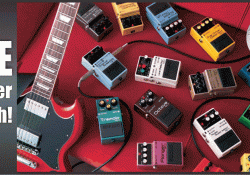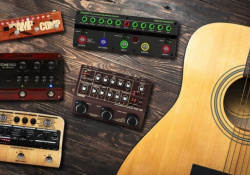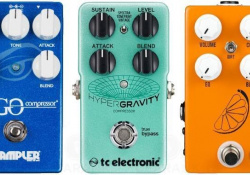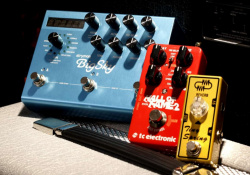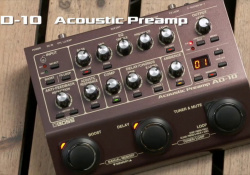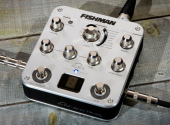
The Handbook for Electro Acoustic Guitarists, Chapter 8: Effects
Does an acoustic guitarist need any effects at all? This is an excellent question, which can be countered with a rhetorical question – Does food need seasoning? Obviously, it's not a must, but it can be much more palatable. Now that we've covered the basic sound as best as we could have in the previous seven episodes of the Handbook, we can boldly move on to add some spices. And, as with food, a good tip is not to overdo the seasoning. The audience won't appreciate an over-salted song but they will savour a spicy hit song on their tongue for a long time.
Acoustic guitarists tend to be much more reticent about effects than their electric relatives, although this has been changing recently. Manufacturers have been offering them countless ways to spend their hard-earned money. So, while you may still see a bard today who comes on stage with only a guitar and not even his own cable, you might as well see an acoustic guitarist with a pedalboard the size of a small airport, overflowing with all manner of colourful boxes. We've been talking about various gadgets in previous episodes of the series. Judging by the new pedalboard I'm putting together right now, it might look like I'll be mercilessly showering you with an avalanche of effects. But don't worry, my biggest focus is always on the basic sound – and two or three ingredients are all you need to spice it up a bit.
Compressor
It is one of the most misunderstood effects, whose absolutely undeserved bad reputation has been built up relentlessly by legions of internet smart alecs who haven't recorded a single song yet. So when you come across some "wisdom" about how compressors destroy dynamics, you can laugh at this nonsense because in the studio almost everything is compressed – and especially acoustic guitar, whose dynamic range from gentle to vigorous strumming is so huge that it's actually impossible to control without compressors. Live, it's not as sensitive, but even there a well-set compressor will do wonders for your guitar. The highly respected YouTuber Paul Davis explains and demonstrates this perfectly with examples.
It's also a good idea not to be swayed by the opinions of electric guitarists, as it's far easier to compress electrics than acoustics (or basses). With acoustics, you'll be looking for so-called transparent compression, which adds a minimum timbre to the original sound, and of course with low noise. Ovnilab – the best site dedicated to compressor reviews will give you plenty of tips on suitable products, from the cheapest to the refined specials. My favourite bon mot that the best compressor can't be heard does seem like a paradox, but you'll understand it immediately when you turn it off. I guarantee you that any sound engineer will thank you for a well-set-up compressor and the listener will enjoy how great it sounds.
Equalizer
We touch on this pretty much all the time, as it's often right up front in the built-in internal preamps of pickups, it can also stand alone as an external effect, and it's always included in some form in the amp/combo. In the video in our earlier part, examples of equalization are demonstrated. So I'll just reiterate that, usually, the acoustic equalizer requires a bit more bass/highs and the mids are pulled down. On the other hand, to accentuate e.g. a solo, the mids are pulled up to make it audible and cut through the mix. But it's a good idea not to overdo it with both bass (feedback or muffled sound) and treble (unpleasantly shrill or rustling sound), and to get a little friendly with the sound engineers and discuss how it would/would not be good to set up because you don't hear the final sound that gets to the audience. So EQ can frequency adjust the sound to the desired shape or maybe kick up the solos. The wide range of EQs starts from single-band (tone knob), dual-band (bass/treble), and obviously tri-band (bass/mid/treble), to multi-band graphic (usually with slides) or parametric (with the option to adjust the frequency and width of the affected band). A special kind of parametric equalizer is a notch filter to suppress feedback, which is partly what the other kinds of equalizer can be used for. So this seemingly subtle effect occurs almost everywhere.
Reverb
The last of the "holy trinity" is reverb. We are well acquainted not only with the bathroom effect, where it reverberates more but also with the majestic effect from churches, for example. A well-chosen reverb will make the sound richer, hotter, spicier... simply more interesting and “edible”. Reverberation is naturally occurring all around us, which is perfectly proven by the experiences of visitors measuring so-called dead chambers (absolutely no reflections and reverberations), who describe strange to very unpleasant sensations. There are many kinds of reverbs – plate, spring, room, hall, cave, shimmer, ambient, modulated, reverse, etc., but I think you can't go wrong with a decent hall reverb for starters. Again, it's a good idea not to overdo it with the settings, as the reverb of the place you're in adds to the sound and it's too easy to "clog" the sound. The types of reverbs you choose clearly depend on the taste of everybody, so try which flavour is right for you and will suitably support your style of playing and music...
These three effects are generally considered the most important and most used in acoustic sound and are also often included in acoustic preamps, combos and multi-effects. Often you'll also find chorus or delay, but these can wear out very quickly and unlike the previous ones, I wouldn't recommend having them on all the time. But do you have to use only special (and significantly more expensive) effects designed for acoustic guitars? Youtuber MusicIsWin can help you crack this dilemma...
So don't be afraid of bass and electric boxes, be careful only with distortion, as that's a very specific discipline with acoustic guitars, and give up in advance the bold idea that, as a cost-saving measure, you might be playing chugga-chugga metal riffs on your acoustic. It doesn't work, and this dead end has been explored by hundreds of enthusiastic experimenters before you (including me :). However, e.g. slightly sharpening the solo sound, ideally using a magnetic pickup (more suitable than a piezo), a volume pedal and some wideband overdrive with a box simulation, is of course possible. So feel free to spice up your performances as you please, even using modulations, octavers, tremolos, phasers or flangers.
The effect theme is in some way inexhaustible because new gear is constantly appearing, which you just have to buy (wives and girlfriends will certainly understand), but as an introduction to the topic and a basic orientation, it is enough. Next time, we'll look at how to turn your Spanish guitar well up!
If you have found an error or typo in the article, please let us know by e-mail info@insounder.org.

